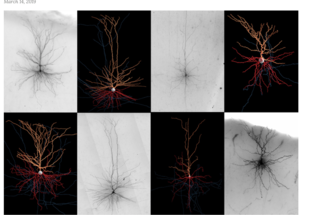Neuroscience
Five Years on, How Fares the BRAIN Initiative?
Collaborative labs are inventing powerful tools for studying the human brain.
Posted April 27, 2019
The BRAIN Initiative, a 10-year science and engineering grand challenge announced by President Obama six years ago, had a visionary mission: to fund the invention of new techniques for understanding brains. This mission reflects the realization that neuroscience cannot help but be profoundly tool-dependent. We would have no clue about neurons and their basic input-output functions without the engineers who drew upon background physics and chemistry and made the tools.
Roughly 600 conditions afflict human brains. Most are devastating and none are well understood. The human cost in suffering is staggering. Likewise, the dollar cost. Considering only Alzheimer’s disease, the cost per patient per year is about $300,000. The total cost per year is about $280 billion in the USA alone. That sum would build a lot of schools and parks. Consequently, preventing and treating brain disorders are a high priority.
Tool and technique development were emphasized in the founding BRAIN documents because brain networks—the organizational levels between single neurons and large-scale systems—have been largely inaccessible to research. Electrodes can access neurons, and scanning devices such as MRI can access large systems. Interposed, the micro and meso and macro networks ply their trade. New tools are needed to pry open their secrets.

Moreover, the cells that make up these network properties are not all the same. Hordes of distinct cell types populate the brain, and each type appears to have its own appropriate location and connectivity pattern, as well as its own response portfolio. How many types are there? What are their distinct connectivity profiles? How do the differences in properties make a difference in how the whole network works? Mostly, answers are not known. But does that matter? Well, not knowing this is like trying to understand air or water without knowing about the periodic table. More directly, here is one example of the potential: preliminary data indicate that mis-located neuron types resulting in atypically organized circuits are at the root of developmental disorders such as schizophrenia and autism. Knowing what each type of cell does under normal circumstances helps us understand what goes wrong in atypical conditions.
To boost innovation, the BRAIN steering committee proposed fostering serious collaborations that span neuroscience, engineering, physics, genetics, mathematics, medicine, and chemistry. The ‘serious’ bit meant that real funding—not measly, token funding—would be available for collaborations aiming to realize specific, inspired, and sometimes daring ideas. A bold strategy, perhaps, but it was sensible. The history of door-opening neuro-inventions, including fMRI, 2-photon microscopy, and optogenetics, gave the proposal real heft. Each of these developments emerged when “if only we could measure…” rubbed shoulders with “let’s build a device that can do it.”
So how does this somewhat risky investment look, five years on? Cautiously, I would say spectacular. On April 11 and 12 I attended the annual meeting of the BRAIN initiative in DC that brought together the people from the funded labs, as well as the scientific administrators at NIH and anyone else who was interested. The drive, dedication, and excitement were clearly evident. A kind of “moon-landing” spirit pervaded the meeting generally.
Two funded technologies—brain organoids and portable MRI machines—captured my imagination. Both involve innovative technology, as well as basic research with major health implications.
Organoids[1]
Neuro-wish: To see in real time how neural structures develop in the human brain. That could yield insight into developmental disorders such as autism, schizophrenia, as well as the effects of the Zika virus. It could tell us about neuron types and how distinct circuits get formed.
Nanotechnology idea: Let’s grow a small sphere of human brain tissue and watch the developmental process in miniature. Insights from the minibrain balls may be transferrable to real neurodevelopment in vivo. Start with induced pluripotent stem cells, watch them differentiate into specialized neurons in a conducive environment (a rotating bioreactor). Use the skin cells of schizophrenics to make pluripotent cells that carry whatever genes are implicated in the condition. See how genetic variants make a difference to neuronal fate. Because the study of human brain developments is necessarily very limited, the promise of human brain organoids is especially significant.
Nanotechnology product: The neurons in brain organoids self-organize into layers and connections that are remarkably similar to what one sees in vivo in the cortex. Once the adequate bioreactor conditions were hit upon, it was found that the progenitor cells begin to differentiate into specific neuron types, migrating consistently to specific neighborhoods, and sprouting structures that make connections that resemble the pattern seen in fetal brains. (2-D tissue culture—growing cells on a Petri dish—has long been used to good effect, but the shortcoming is that cell growth and connectivity are random.) Organoid technology is in its early stages, and much remains unsolved to approximate more closely in vivo neuronal development. Nevertheless, discoveries are already coming in. For example, using this technology, it was found that the Zika virus infects very young pre-neuron cells—so young they have yet to receive signals that will turn them into neurons. The disruption alters subsequent cell divisions that yield neurons and their differentiation into specific neuron types. [2]
Brain organoids are not brains. For one thing, they have neither sensory input nor motor output, though ideas are afoot to achieve these interactions. Although it has been suggested that a whole human brain could easily be created in a bioreactor, at this stage the fantasy is far-fetched. Nevertheless, ethical questions do arise. For example, research on the pain system, though urgently needed, is challenging because inflicting pain to understand the system troubles the conscience. Can organoids be the long-sought platform for studying pain, or can even organoids feel pain? How could we test for that?
Portable MRI
Neuro-wish: To have a cheaper, smaller brain scanner that is more patient-friendly.
Nanotechnology development: A portable MRI scanner, weighing only about a thousand pounds, that can be loaded onto the back of a pick-up truck. The new configuration lets the subject sit upright, and the business end lowers down over the head to the shoulders. Thus it does not confine the whole body in a prone position. A small window has been inserted at eye level to reduce any claustrophobic reaction and allow for visual stimuli. The prototype is up and running, and refinements are in progress. [3]
The Value: The portable scanner makes brain imaging with MRI much cheaper, and it means the scanner may be affordable in smaller hospitals in rural areas, or it may be trucked between small hospitals in a group. Scanning may therefore be available to communities that hitherto have been unable to afford the cost of a scan or the cost of travel. Clinically, the MRI can detect inflammation that may be caused by meningitis, a potentially fatal disease, or it can detect cysts and tumors that may be the cause of headaches. For research neuroscience, the payoff will be a wider range of individuals who can be scanned, thus expanding and improving the database.
Brain organoids and portable MRI are pioneering projects, and for all we can tell now, further tinkering may yield tools that look vastly different from the early prototypes. Nevertheless, for both projects, the potential is rich indeed. Many other BRAIN-supported technologies are also in development, all aiming to find new and better ways to measure what networks of neurons do, in both healthy and diseased brains.
References
[1]Paola Arlotta, Nature Methods 15, 270-29 (2018); Neil Amin & Sergiu Pasca Neuron 100, 389-405 (2018). See also Allyson Muotri Lab, https://medschool.ucsd.edu/som/pediatrics/research/labs/muotri-lab/Page…
[2]G.L. Ming, H. Tang & H. Song, Cell Stem Cell 19, 690-702 (2016)
[3]See Michael Garwood, https://www.med.umn.edu/bio/department-of-radiology/michael-garwood




